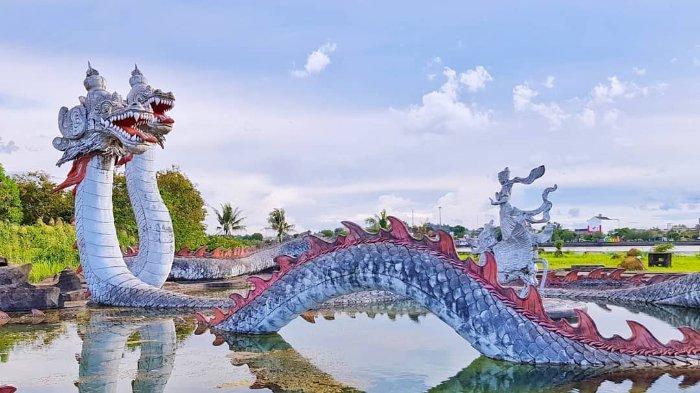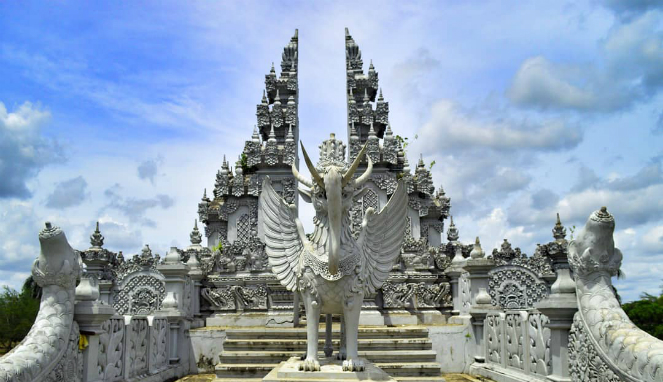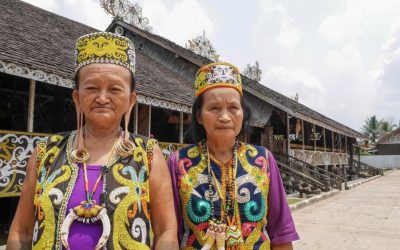Home / Batik Regions – Central Indonesia – Kalimantan Island – East Kalimantan / Kumala Island of Mahakam River
Cultural Destination
Embrace the spirit of the place!
Kumala Island of Mahakam River
The monument of Princess Karang Melenu and Erau Dragon (photo: @tribunswiki)
Hindu Shrine, Pura Pasak in Kumala Island (photo: Femina)
Kumala Island of Mahakam River
Do you want to fully experience the legacy of Kutai Kartanegara, the first kingdom in Kutai? Don’t miss Kumala Island. It is an 81-hectare delta that looks like a ship in the middle of the Mahakam River. Kumala Island is a new tourist park associated with many local myths, such as the Lembuswana of the Kutai Kingdom, the legend of Karang Melenu, the legend of the Princess and Erau Dragon. It also has the Pura Pasak Hindu shrine, which is known for its exquisite sculptures, as well as a traditional Dayak building that serves as a cultural centre. The island also has many modern entertainment facilities such as horse-drawn carriages, go-carts, and river tour boats. It is accessible through the bridge that connects it with Tenggarong City.
Tourist Attractions in East Kalimantan
Pampang Cultural Village
This area is inhabited by Dayak Kenyah and once a year they
Batik villages in East Kalimantan
Home / Batik Regions - Central Indonesia - Kalimantan Island - East Kalimantan / Batik Village in East Kalimantan Batik Village in East Kalimantansupport the local workshop Brief Story: This unique batik from East Kalimantan are made with various materials. Some...
East Kalimantan
Batik Motifs
Kuntul Perak
Kuntul Perak refers to Egret Silver Bird. This bird is a Kalimantan endemic animal that becomes the
Tengkawang Ampiek
With its many advantages, the Dayaks use this leaf in ritual ceremonies. This plant is a symbol of
Hiu Taliyasan
Indonesia is also home to the world’s largest fish, the whale shark (Rhincodon typus). Hiu Taliyasan refers to
Discover
Indonesian
Batik
Motifs
Srimanganti
The name of the Srimanganti motif is derived from Palace’s hallway that connects to
Tifa Totobuang
The batik motifs illustrate Maluku’s traditional music instrument called
Pala Salawaku
This motif illustrates the unique weapons of the Maluku region, namely
Jumputan Bintang
The word Jumputan means the tie-dye technique, while the word “Bintang” refers to
Gamolan
This motif illustrates Gamolan, a bamboo musical instrument of Lampung that is
Pinawetengan
The Pinawetengan Batik pattern was taken from a prehistoric inscription in
Lontara
The Lontara script itself is a typical ancient script of Bugis and Makassar communities. History records that
Mahkota Siger
Siger is the crown of a noblewoman in ancient time. It is a symbol of femininity, strength, and
Rumah Mamuju
the Batik motif illustrates the house of Mamuju King with the stairs, located on the left of the wooden stage house
Bintik Tujuh
The Bintik Tujuh (Seven Dots) motif has 7 white spots and green color gradation as
Raja Ampat
Raja Ampat motif represents the marine life at Raja Ampat archipelago in
Lok Baintan Floating Market
As you can imagine, the most authentic thing is that you can buy things and even
Besurek Rafflesia
The term “Basurek” refers to a textile that contains letters or inscriptions
Lipaq Sabe
Lipaq Saqbe contains a simple geometric classical motif with various flower decorations. This textile is
Keluak Daun Pakis
The word “Keluak” is a Minang language which means twisted or tangled. The Motif of
Bekantan Pakis
This motif represents Pakis Haji (Polystichum setiferum), an endemic plant in
Sido Mulyo
Sidomulyo is one of the classical motifs, which is specifically used for the bride’s costume in
Tangerang Herang
Tangerang Herang motif is a symbol of Tangerang city. The Tangerang Herang batik motif consists of
Gumin Tambun
Based on Hindu mythology, this motif symbolizes lucks, abundant wealth, and
Sekomandi
Its philosophical meaning is the eternal union which refers to a saying “until death do us part”
Tikar Natuna
The Tikar Natuna motif is adapted from the traditional making of pandanus mats in
Singayaksa
The Singayaksa motif comes from the name of a place where Sultan Hasanuddin used to
Tubo Kelapa
Coconut tree is a symbol of a good character and strong mentality. It illustrates the more success a person, the more
Bomba Mawar
This motif means sacred love for family, kingdom, and God; It also illustrates
Gonggong Siput
Gonggong (Strombus Turturella) is one type of sea snail found around
Angsa Duo
According to legend, the Angso duo batik motif is a pair of swans that are believed to have led Princess
Tengkawang Ampiek
With its many advantages, the Dayaks use this leaf in ritual ceremonies. This plant is a symbol of
Salakanagara
Salakanagara batik motif illustrates the first kingdom in the Betawi land
Tabir Tanjung
Tanjung flower is a type of Cherry tree flower, which is commonly found in
Honai
The Honai is inspired by the traditional house of the Papuan community living in
Merak Ngeram
The hatching peacock motif has a very deep meaning which refers to the sacrifice and
Daun Lada Hitam
The black pepper motif represents the main commodity of Bangka Belitung
Ikan tambal
The word “Ikan” refers to fish. The philosophical meaning of Ikan Tambal means is
Prada Papua
The word “Prada” in the Javanese-Indonesian dialect means a batik textile that
Wirasat
Wirasat or divine inspiration is a gift from God. This inspiration is symbolized by
Bultiya
The word ‘Bultiya’ is an acronym of the three major tribes in North Kalimantan, namely
Biji Kopi
The coffee seeds motif illustrates the pride of local coffee specialities in
Bale Lumbu
This motif signifies the welfare of the ancient Sasak society. Bale also symbolizes the
Malinau Cultural Festival
You will witness a unique competition that might not be found other than in
Gorga Simeol-Meol
The Gorga Simeol-meol is a pattern of plant tendrils. it is regarded as a symbol of longevity and
Dayak Taghol
Dayak Taghol has a distinctive style of four curved lines and small dots. This motif represents
Tanah Liek
The word “Tanah Liek” refers to clay in Minang language. It is also known as
Jupri Kembang Teh
Kembang Teh illustrates the tendrils of tea plants that grow in the highlands of
Kaharingan
The Kaharingan or ‘tree of life’ based on the Dayak tribes’ belief system. This tree symbolizes
Sandeq
Sandeq Boat is a symbol of the maritime importance of the West Sulawesi region. The greatness of
Pati-Pati Pinehiku
It symbolizes the hierarchy in society and the social status of the Mekongga
Awan Berarak
Awan Berarak is a combination of Dayak motifs and Malay patterns. The word ‘Awan Berarak’ means the
Pohon Hayat (Tree of Life)
The Batik motifs in Lampung are dominated by the acculturation of Buddhist and
Enggang Dayak
Local people beliefs that hornbills are an incarnation of the Commander of the Birds. It has supernatural
Kasih Tak Sampai
‘Kasih Tak Sampai’ is an idiom in the Indonesian language which refers to
Sekar Jati
Sekar means flower and Jati refers to teak trees that symbolizes a strong mental character that
Daun Sirih
This motif illustrates betel leaves that are used by Lombok communities as traditional
La Galigo
La Galigo is a literary work of the Buginese Epic that has 300 thousand epic lines. It is considered even
Hiu Taliyasan
Indonesia is also home to the world’s largest fish, the whale shark (Rhincodon typus). Hiu Taliyasan refers to
Besurek Rembulan
This batik illustrates praise for God who created the wonderful universe
Kaganga Tanah Rejang
If Batik Besurek combines Arabic calligraphy motifs, then the Kaganga batik takes
Burung Bidadari
Bidadari birds are endemic birds in Halmahera. This motif represents an
Tenun Bima
The motifs are adopted from Bima woven textile. This pattern has received a great
Tongkonan
Toraja’s traditional house is called Tongkonan. Tongkonan is a place for
Kerawang Tegak Aceh
The Vertical Upright (Kerawang Tegak) Motif symbolizes a person who has a strong
Gajah Way Kambas
The motif illustrates the Lampung’s natural reserve, the Way Kambas. it also symbolizes
Ukir Sentani
The Ukir motif is a batik motif that is inspired by various traditional Sentani wood carvings
Parang Rusak
Another meaning behind this motif is an unconquerable spirit, symbolized by
Pucuk Rebung Riau
Pucuk Rebung symbolizes heart determination in achieving goals, good luck, and
Daun Simpor
This motif is inspired by the Simpor plant (Dillenia Suffruticosa) which is a typical
Buketan Bali
The Balinese bouquet (Buketan Bali) is a floral arrangement and the name is
Karawo Pinang
Pinang refers to the Palm areca tree. This motif is considered as the original
Gigi Haruan Lidi
The Gigi Haruan Lidi motif is taken from the name of the cork fish and is a symbol of
Gurdo Solo
Gurdo or garuda bird is the mount of the Indian god Vishnu. As the Sun Bird,
Gedhog Kembang Waluh
a combination of Javanese cultural motif of the Majapahit kingdom (XII-XIV century) with
Cengkeh
The clove flower motif is the main commodity of the Tolitoli Regency. This motif represents
Manguni Minahasa
Manguni is identified as the symbol of the Minahasa people. Manguni is known as a
Taiganja
Taiganja is a precious gold pendant that shows the social status of the Kaili family. It is
Kawung
The Kawung motif was created by Sultan Agung Hanyokrokusumo (1593 – 1645) as a symbolic gift for
Ake Patra
Ake is related to the divinity and the composition of the universe. It is a symbol of



